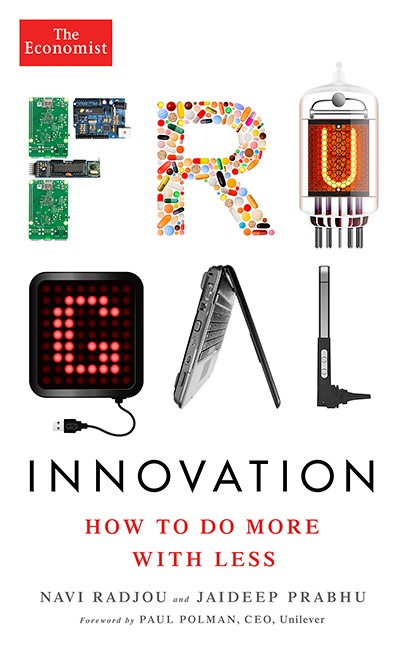Frugal Innovation: How to Do More With Less by Navi Radjou & Jaideep Prabhu
February 19, 2015
PublicAffairs and The Economist team up with two brilliant authors to show us how to create more value with the increasingly limited resources available to us.

Frugal Innovation: How to Do More With Less by Navi Radjou & Jaideep Prabhu, The Economist, 272 pages, $18.99, Paperback, February 2015, ISBN 9781610395052
After the financial downturn and widespread layoffs that left so many without work, and those still working with more to do and less people to do it with, you may be tired of hearing that you have to “do more with less.” But Frugal Innovation isn’t really about that. It is about how to survive and better serve your customers in a more discerning and conscientious marketplace, and a world of diminishing resources—without diminishing your company’s returns.
The authors put out a brilliant book in 2012 called Jugaad Innovation that looked at ways companies in the emerging, energetic economies of the so-called BRIC countries (specifically Brazil, India, and China) were achieving great results with constrained resources. Since then, they’ve encountered “an explosion of interest” in these approaches in the developed economies of the west, for good reason:
Western companies are facing growing pressure from cost-conscious and eco-aware customers, employees and governments, who are demanding affordable, sustainable and high-quality products. Frugal innovation is therefore a game-changing business strategy. But it is more than a strategy: it denotes a new frame of mind, one that sees resource constraints as an opportunity, not a liability.
The authors espouse six principles—practices, really—to embed in your organization to engage that strategy and achieve that frame of mind: engage and iterate, flex your assets, create sustainable solutions, shape customer behavior, engage “prosumers,” and make innovative friends. They devote a chapter to each principle, and I found myself drawn immediately to the chapter on sustainable solutions and the story of Tarkett, a company that makes flooring for homes, offices, hospitals, and schools, and field surfaces for stadiums.
CEO Michael Giannuzzi took over the company in 2007, at a time when it was growing over 10% annually. This is a dream scenario for most incoming CEOs, but Giannuzzi realized the company’s rapid growth meant that it would have to consume more and more non-renewable, increasingly expensive resources, making that level of growth unsustainable both environmentally and financially. So he reinvented the company’s business model and “radically changed the way the company designs, makes, sells and maintains all its products, embedding environmental sustainability at every stage of its product life cycle.” A quote from Giannuzzi shows his belief that this approach has been a key component of his company’s continued success:
Far from being a business constraint, corporate sustainability is an opportunity to continuously improve our operations, and to innovate and differentiate our brand in a highly competitive marketplace.
The best way to improve operations and innovate is to fully engage your employees in the process. Anne-Christine Ayed, Tarkettt’s head of research, innovation, and environment (that title alone is an indicator of the company’s focus), explains how their new focus helps that:
The only non-depletable resource in the world is human ingenuity. We use sustainability as a powerful lever to unleash all our employees’ ingenuity.
The authors wrap up with a chapter on “Fostering a frugal culture” that helps you begin to think more pragmatically about the next (possibly first) steps of their own organizational transformation, and how to go about “shifting the thinking and behavior of staff.” Rather than hiring expensive consultants to study the company and come up with a top-down approach, authors Radju and Prabhu describe a trial and error process that employees are an active participant in. Since employees are engaged in each iteration and aware of decisions as they’re made, this negates the need for getting buy-in from employees at the end of the process. It is also dramatically cheaper, to boot—frugal innovation indeed.
As we enter what many call an “age of scarcity,” it behooves us all to adapt, and those that do so first will have a huge competitive advantage from an operational and image standpoint. Navi Radjou and Jaideep Prabhu have written the guide.



